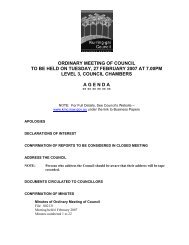Ku-ring-gai Heritage Conservation Areas North Inventory Sheet
Ku-ring-gai Heritage Conservation Areas North Inventory Sheet
Ku-ring-gai Heritage Conservation Areas North Inventory Sheet
You also want an ePaper? Increase the reach of your titles
YUMPU automatically turns print PDFs into web optimized ePapers that Google loves.
<strong>Ku</strong>-<strong>ring</strong>-<strong>gai</strong><br />
<strong>Heritage</strong> <strong>Conservation</strong> <strong>Areas</strong> <strong>North</strong> <strong>Inventory</strong> <strong>Sheet</strong><br />
Item No<br />
Item Name<br />
Item Type<br />
Group Collection<br />
Category<br />
Key Historical<br />
Periods<br />
Primary Address<br />
Local Govt. area<br />
HCA 18 part<br />
ORINOCO STREET HERITAGE CONSERVATION AREA<br />
<strong>Heritage</strong> <strong>Conservation</strong> Area<br />
Urban Area<br />
Townscape<br />
Federation, Inter-war<br />
Refer to map<br />
<strong>Ku</strong>-<strong>ring</strong>-<strong>gai</strong><br />
Boundaries<br />
The area encompasses Nos. 1-31 Orinoco Street (including 5a Orinoco Street and 2-14 Orinoco Street,<br />
16 Livingstone Avenue, and 30 to 38 Livingstone Avenue, Pymble<br />
National Historic Themes<br />
State Historic Theme 1<br />
State Historic Theme 2<br />
State Historic Theme 3<br />
State Historic Theme 4<br />
Building settlements towns and cities<br />
Towns, suburbs and villages<br />
Persons<br />
Summary<br />
Statement of<br />
Significance<br />
Orinoco Street is significant historically and aesthetically as an highly intact portion of the 1894<br />
Hamilton Estate subdivision developed from the early 20th century, and for its collection of Peddle<br />
Thorp designed bungalows. The <strong>Heritage</strong> <strong>Conservation</strong> Area boundary also encompasses 16<br />
Livingstone Avenue, a house designed 1956-57 by architects Morrow & Gordon for Grace Irene<br />
Gordon, wife of Percy J. Gordon architect, principal of the firm at the time, as his family residence.<br />
The area is considered rare for its concentration of housing designed by a single architectural firm<br />
(Peddle Thorp later Peddle Thorp & Walker) between 1913 and 1930, and for its collection of fine<br />
inter war period housing at the southern end of Orinoco Street, wrapping around into Livingstone<br />
Avenue.<br />
The name <strong>Ku</strong>-<strong>ring</strong>-<strong>gai</strong> comes from the <strong>Ku</strong><strong>ring</strong><strong>gai</strong> or Gu<strong>ring</strong>ai Aboriginal language group of the people<br />
who inhabited the area from Port Jackson north across Broken Bay and beyond Brisbane Water. The<br />
name has been adopted for both the Local Government area and the adjacent National Park to the<br />
north. There were two bands of the Gu<strong>ring</strong>ai in what is now the <strong>Ku</strong>-<strong>ring</strong>-<strong>gai</strong> Local Government area:<br />
the Garrigal or Carigal people, who lived around West Head, and the Terramerragal, who lived in the<br />
Turramurra area.<br />
A ridge-top pathway made by the Gu<strong>ring</strong>ai people was the route followed by what is now the Pacific<br />
Highway through <strong>Ku</strong>-<strong>ring</strong>-<strong>gai</strong>.<br />
Within six weeks of the arrival of the British First Fleet in Sydney in 1788, Governor Phillip went<br />
explo<strong>ring</strong> around Broken Bay, and commented on the friendliness of the Aboriginal people. However,<br />
when he returned a year later, all except those too sick with smallpox fled from him. By 1790, over<br />
half of the Gu<strong>ring</strong>ai nation had been wiped out by smallpox. By the 1840s, most of the Aboriginal<br />
people had disappeared from Pittwater and their traditional lands had been taken over by white<br />
settlers. Some Gu<strong>ring</strong>ai survivors of the small pox epidemic formed what was known to the British<br />
colonists as the Broken Bay tribe led by Bungaree, who was notable for completing the first<br />
KU-RING-GAI HERITAGE CONSERVATION AREAS NORTH INVENTORY

















